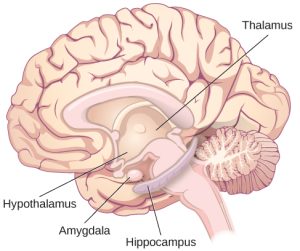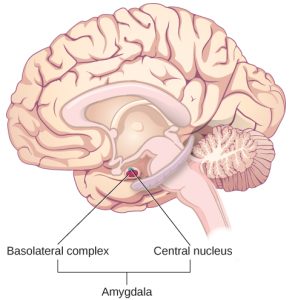The Biology of Emotions
Learning Objectives
- Describe the role that limbic structures play in emotional processing
Earlier, you learned about the limbic system, which is the area of the brain involved in emotion and memory (Figure 1). The limbic system includes the hypothalamus, thalamus, amygdala, and the hippocampus. The hypothalamus plays a role in the activation of the sympathetic nervous system that is a part of any given emotional reaction. The thalamus serves as a sensory relay center whose neurons project to both the amygdala and the higher cortical regions for further processing. The amygdala plays a role in processing emotional information and sending that information on to cortical structures (Fossati, 2012).The hippocampus integrates emotional experience with cognition (Femenía, Gómez-Galán, Lindskog, & Magara, 2012).

Link to Learning
Work through this Open Colleges interactive 3D brain simulator for a refresher on the brain’s parts and their functions. To begin, click the “Start Exploring” button. To access the limbic system, click the plus sign in the right-hand menu (set of three tabs).
Amygdala
The amygdala has received a great deal of attention from researchers interested in understanding the biological basis for emotions, especially fear and anxiety (Blackford & Pine, 2012; Goosens & Maren, 2002; Maren, Phan, & Liberzon, 2013). The amygdala is composed of various subnuclei, including the basolateral complex and the central nucleus (Figure 2). The basolateral complex has dense connections with a variety of sensory areas of the brain. It is critical for classical conditioning and for attaching emotional value to learning processes and memory. The central nucleus plays a role in attention, and it has connections with the hypothalamus and various brainstem areas to regulate the autonomic nervous and endocrine systems’ activity (Pessoa, 2010).

Animal research has demonstrated that there is increased activation of the amygdala in rat pups that have odor cues paired with electrical shock when their mother is absent. This leads to an aversion to the odor cue that suggests the rats learned to fear the odor cue. Interestingly, when the mother was present, the rats actually showed a preference for the odor cue despite its association with an electrical shock. This preference was associated with no increases in amygdala activation. This suggests a differential effect on the amygdala by the context (the presence or absence of the mother) determined whether the pups learned to fear the odor or to be attracted to it (Moriceau & Sullivan, 2006).
Raineki, Cortés, Belnoue, and Sullivan (2012) demonstrated that, in rats, negative early life experiences could alter the function of the amygdala and result in adolescent patterns of behavior that mimic human mood disorders. In this study, rat pups received either abusive or normal treatment during postnatal days 8–12. There were two forms of abusive treatment. The first form of abusive treatment had an insufficient bedding condition. The mother rat had insufficient bedding material in her cage to build a proper nest that resulted in her spending more time away from her pups trying to construct a nest and less times nursing her pups. The second form of abusive treatment had an associative learning task that involved pairing odors and an electrical stimulus in the absence of the mother, as described above. The control group was in a cage with sufficient bedding and was left undisturbed with their mothers during the same time period. The rat pups that experienced abuse were much more likely to exhibit depressive-like symptoms during adolescence when compared to controls. These depressive-like behaviors were associated with increased activation of the amygdala.
Human research also suggests a relationship between the amygdala and psychological disorders of mood or anxiety. Changes in amygdala structure and function have been demonstrated in adolescents who are either at-risk or have been diagnosed with various mood and/or anxiety disorders (Miguel-Hidalgo, 2013; Qin et al., 2013). It has also been suggested that functional differences in the amygdala could serve as a biomarker to differentiate individuals suffering from bipolar disorder from those suffering from major depressive disorder (Fournier, Keener, Almeida, Kronhaus, & Phillips, 2013).
Hippocampus
As mentioned earlier, the hippocampus is also involved in emotional processing. Like the amygdala, research has demonstrated that hippocampal structure and function are linked to a variety of mood and anxiety disorders. Individuals suffering from posttraumatic stress disorder (PTSD) show marked reductions in the volume of several parts of the hippocampus, which may result from decreased levels of neurogenesis and dendritic branching (the generation of new neurons and the generation of new dendrites in existing neurons, respectively) (Wang et al., 2010). While it is impossible to make a causal claim with correlational research like this, studies have demonstrated behavioral improvements and hippocampal volume increases following either pharmacological or cognitive-behavioral therapy in individuals suffering from PTSD (Bremner & Vermetten, 2004; Levy-Gigi, Szabó, Kelemen, & Kéri, 2013).
attribution
Emotion. Authored by: OpenStax College. Located at: https://openstax.org/books/psychology-2e/pages/10-4-emotion. License: CC BY: Attribution. License Terms: Download for free at https://openstax.org/books/psychology-2e/pages/1-introduction
part of the brain with dense connections with a variety of sensory areas of the brain; it is critical for classical conditioning and attaching emotional value to memory
part of the brain involved in attention and has connections with the hypothalamus and various brainstem areas to regulate the autonomic nervous and endocrine systems’ activity

